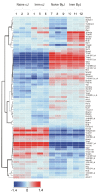BALB/c mice genetically susceptible to proteoglycan-induced arthritis and spondylitis show colony-dependent differences in disease penetrance
- PMID: 19220900
- PMCID: PMC2688253
- DOI: 10.1186/ar2613
BALB/c mice genetically susceptible to proteoglycan-induced arthritis and spondylitis show colony-dependent differences in disease penetrance
Abstract
Introduction: The major histocompatibility complex (H-2d) and non-major histocompatibility complex genetic backgrounds make the BALB/c strain highly susceptible to inflammatory arthritis and spondylitis. Although different BALB/c colonies develop proteoglycan-induced arthritis and proteoglycan-induced spondylitis in response to immunization with human cartilage proteoglycan, they show significant differences in disease penetrance despite being maintained by the same vendor at either the same or a different location.
Methods: BALB/c female mice (24 to 26 weeks old after 4 weeks of acclimatization) were immunized with a suboptimal dose of cartilage proteoglycan to explore even minute differences among 11 subcolonies purchased from five different vendors. In vitro-measured T-cell responses, and serum cytokines and (auto)antibodies were correlated with arthritis (and spondylitis) phenotypic scores. cDNA microarrays were also performed using spleen cells of naïve and immunized BALB/cJ and BALB/cByJ mice (both colonies from The Jackson Laboratory, Bar Harbor, ME, USA), which represent the two major BALB/c sublines.
Results: The 11 BALB/c colonies could be separated into high (n = 3), average (n = 6), and low (n = 2) responder groups based upon their arthritis scores. While the clinical phenotypes showed significant differences, only a few immune parameters correlated with clinical or histopathological abnormalities, and seemingly none of them affected differences found in altered clinical phenotypes (onset time, severity or incidence of arthritis, or severity and progression of spondylitis). Affymetrix assay (Affymetrix, Santa Clara, CA, USA) explored 77 differentially expressed genes (at a significant level, P < 0.05) between The Jackson Laboratory's BALB/cJ (original) and BALB/cByJ (transferred from the National Institutes of Health, Bethesda, MD, USA). Fourteen of the 77 differentially expressed genes had unknown function; 24 of 77 genes showed over twofold differences, and only 8 genes were induced by immunization, some in both colonies.
Conclusions: Using different subcolonies of the BALB/c strain, we can detect significant differences in arthritis phenotypes, single-nucleotide polymorphisms (SNPs), and a large number of differentially expressed genes, even in non-immunized animals. A number of the known genes (and SNPs) are associated with immune responses and/or arthritis in this genetically arthritis-prone murine strain, and a number of genes of as-yet-unknown function may affect or modify clinical phenotypes of arthritis and/or spondylitis.
Figures


Comment in
-
Colony variability under the spotlight in animal models of arthritis.Arthritis Res Ther. 2009;11(2):110. doi: 10.1186/ar2653. Epub 2009 Apr 30. Arthritis Res Ther. 2009. PMID: 19439055 Free PMC article.
Similar articles
-
Variations in susceptibility to proteoglycan-induced arthritis and spondylitis among C3H substrains of mice: evidence of genetically acquired resistance to autoimmune disease.Arthritis Rheum. 2001 Mar;44(3):682-92. doi: 10.1002/1529-0131(200103)44:3<682::AID-ANR118>3.0.CO;2-E. Arthritis Rheum. 2001. PMID: 11263784
-
A longitudinal study on an autoimmune murine model of ankylosing spondylitis.Ann Rheum Dis. 2005 Jul;64(7):981-7. doi: 10.1136/ard.2004.029710. Epub 2005 Jan 7. Ann Rheum Dis. 2005. PMID: 15640265 Free PMC article.
-
The genetic background of ankylosing spondylitis.Joint Bone Spine. 2009 Dec;76(6):623-8. doi: 10.1016/j.jbspin.2009.02.006. Joint Bone Spine. 2009. PMID: 19541528 Review.
-
Proteoglycan-induced arthritis in BALB/c mice. Clinical features and histopathology.Arthritis Rheum. 1987 Feb;30(2):201-12. doi: 10.1002/art.1780300211. Arthritis Rheum. 1987. PMID: 3827960
-
Proteoglycan-specific autoreactive antibodies and T-lymphocytes in experimental arthritis and human rheumatoid joint diseases.Biochem Soc Trans. 1990 Oct;18(5):796-9. doi: 10.1042/bst0180796. Biochem Soc Trans. 1990. PMID: 2083679 Review. No abstract available.
Cited by
-
Characterization of excretory/secretory products of the Taenia crassiceps cysticercus involved in the induction of regulatory T cells in vivo.Parasitol Res. 2023 Jul;122(7):1489-1497. doi: 10.1007/s00436-023-07847-x. Epub 2023 Apr 28. Parasitol Res. 2023. PMID: 37115316
-
Rheumatoid arthritis vaccine therapies: perspectives and lessons from therapeutic ligand epitope antigen presentation system vaccines for models of rheumatoid arthritis.Expert Rev Vaccines. 2015 Jun;14(6):891-908. doi: 10.1586/14760584.2015.1026330. Epub 2015 Mar 18. Expert Rev Vaccines. 2015. PMID: 25787143 Free PMC article. Review.
-
Colony variability under the spotlight in animal models of arthritis.Arthritis Res Ther. 2009;11(2):110. doi: 10.1186/ar2653. Epub 2009 Apr 30. Arthritis Res Ther. 2009. PMID: 19439055 Free PMC article.
-
Osteoarticular tissue infection and development of skeletal pathology in murine brucellosis.Dis Model Mech. 2013 May;6(3):811-8. doi: 10.1242/dmm.011056. Epub 2013 Mar 8. Dis Model Mech. 2013. PMID: 23519029 Free PMC article.
-
Immune Relevant and Immune Deficient Mice: Options and Opportunities in Translational Research.ILAR J. 2018 Dec 31;59(3):211-246. doi: 10.1093/ilar/ily026. ILAR J. 2018. PMID: 31197363 Free PMC article. Review.
References
-
- Pearson CM. Development of arthritis, periarthritis and periostitis in rats given adjuvants. Proc Soc Exp Biol Med. 1956;91:95–101. - PubMed
Publication types
MeSH terms
Substances
Grants and funding
LinkOut - more resources
Full Text Sources
Medical
Molecular Biology Databases

